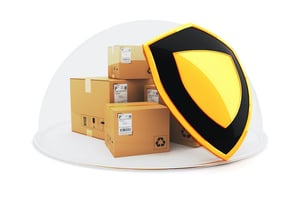 As a shipper, you can do a lot of things to ensure your cargo reaches its destination in the best possible condition. For example, you can choose a reliable carrier, take extra care when packing your shipment and provide thorough handling instructions.
As a shipper, you can do a lot of things to ensure your cargo reaches its destination in the best possible condition. For example, you can choose a reliable carrier, take extra care when packing your shipment and provide thorough handling instructions.
No matter what, though, some elements will always be out of your control. And that’s when cargo insurance coverage comes in handy.
But what does cargo insurance do, exactly? And what do you need to know to make sure you’re selecting the right coverage?
Unfortunately, misunderstandings around responsibility and liability can be costly. To help ensure you’re taking all the necessary precautions, we’re breaking down the basics.
What Is Cargo Insurance?
Cargo insurance is a form of protection that covers against risks of damage or physical loss of freight during shipment.
Typically, the auto liability policy carriers maintain on their fleet of vehicles, such as cargo van insurance, doesn't cover a shipper’s cargo. But a cargo policy (which may be purchased by the carrier, or shipper — and often both) will protect your goods.
6 Things Shippers Need to Know When Purchasing Cargo Insurance
Before you purchase cargo insurance from a broker, there are six things you need to know:
- The value of your product: One of the biggest mistakes shippers make when choosing coverage is undervaluing their goods. Doing this means that, if an incident occurs, you may not receive a large enough payout and will be forced to eat the remaining cost.
If there’s one piece of advice we can give, it’s to value your shipments as accurately as possible. - The type and level of coverage you need: Many carriers purchase a cargo policy to make themselves more enticing to shippers, but this coverage isn’t always enough. And just because a carrier has a certificate of insurance with a stated amount of cargo insurance, doesn’t mean your claim will be covered.
To protect your goods, be sure to find out how much insurance your carrier has, and what that insurance covers. Then, secure a policy that makes up the difference. - The coverage exclusions: The last thing you want is to invest in a cargo insurance policy and file a claim, only to discover it doesn’t cover the incident you’ve experienced.
Exclusions vary by policy and cargo type, but a few examples of possible exclusions include:- If the cargo becomes wet and ruined due to rain
- If the freight isn't correctly connected to the trailer
- If the trailer isn't properly attached to the tractor
- If the truck’s refrigeration system fails
Before you purchase a policy, make sure it covers your exact type of cargo. For example, if you’re transporting refrigerated goods, you’ll need a reefer breakdown policy. - Your responsibilities under the Carmack Amendment: The Carmack Amendment is a law adopted by Congress in 1935, and it establishes a uniform set of rules governing interstate shipments. Before the Carmack Amendment became law, each state had its own unique processes for handling cargo insurance and loss.
As a shipper, you have three responsibilities under this amendment:- You must prove the goods were in good condition when you provided them to the carrier
- You must verify the goods were damaged when they were delivered (or when the incident occurred that prevented delivery)
- You must prove the amount of the damages
There are a few circumstances when you, as the shipper, may not be held liable — such as in the case of an act of God or a crime by a public enemy. - How to become C-TPAT certified: The Customs-Trade Partnership Against Terrorism (C-TPAT) was formed after 9/11 and focuses on improving private companies’ supply chain security in the face of terrorism. To become certified, you must have a documented process for mitigating risk throughout your international supply chain. Once you’re certified, you’ll be considered “low risk” and enjoy expedited cargo processing and less rigorous customs inspections.
It’s important to note that becoming C-TPAT certified (and working with C-TPAT certified carriers) can help lower your insurance premiums. - Your preferred provider’s credibility and safety: Before working with a carrier, it’s crucial you evaluate their trustworthiness, safety and credibility.
There are two ways to do this:- Check their A.M. Best rating
- Ask for their motor carrier number and check their DOT safety rating
If you opt to take on the risk of a provider who has a low A.M. Best or DOT safety rating, you can likely negotiate for the carrier to cover a larger share of the cargo insurance.
While cargo insurance isn’t required, it’s essential to ensuring your shipment is protected. Although you may take every necessary preventative measure, much of the shipment process is out of your control — and a cargo protection policy can help preserve the health of your bottom line.


